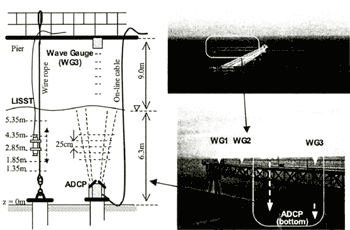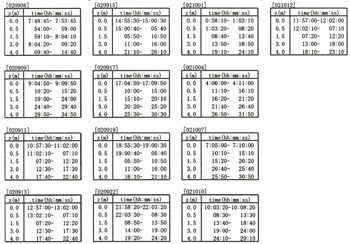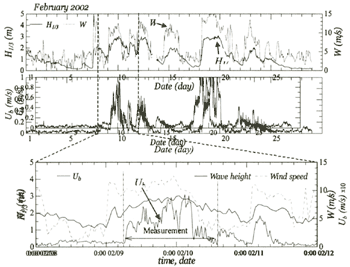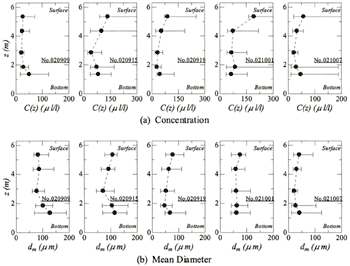|
LISST/ADCP OBSERVATION OF SUSPENDED SEDIMENT PROFILES IN THE SURF ZONE
Shigeru Kato1, Takao Yamashita1 and Abbas Yeganeh Bakhtiary2
1Disaster Prevention Research Institute, Kyoto University
Gokasho, Uji, Kyoto, JAPAN
katou@rcde.dpri.kyoto-u.ac.jp
2Department of Civil Engineering, Iran University of Science & Technology
Tehran, IRAN
ABSTRACT
Undertow (offshore-going current under the strong wind and wave conditions) may be the main cause of severe beach erosion. In the surf zone, undertow induced by the mean sea level set-up due to wind and waves, will be strong enough to transport sediment offshore through the surf zone. It is very important to measure offshore-going sediment transport rate, particularly suspended load, which is directly related to the current. The field observations of (1) the vertical mean current profile by the ADCP, (2) concentration of suspended sediment and its mean diameter by the LISST-25 and (3) wave conditions by ultrasonic-type wave gauges in the nearshore zone, were conducted using the observation pier in the Ogata Coast. A scheme for separation of air bubble and suspension in the LISST-25 data was developed. The vertical profile of suspended sediment and the flux of offshore-going suspended load were estimated with observed profile data of current and sediment concentration under the condition including storm events.
INTRODUCTION
A bursting of undertow (sudden occurrence of strong offshore-going near-bottom
currents) has often been observed in the surf zone under winter storm conditions in the Ogata Coast facing
the Japan Sea ( Yamashita et al., 1998; Kato et al., 2000). This phenomenon
should be generated by mean water set-up due to wind and breaker-induced cross-shore currents and the
velocity frequently exceeds 0.5 m/s, Moreover, they can be observed even in a region of 10-15 m in depth
(near the closure depth for sediment movement). Net volume of cross-shore sediment transport and sediment
sorting may be determined by the power relationship between suspended load and bed load and the current
fields combined wave motion with undertow. Suspended load in the surf zone can be generated with combined
current fields of undertow and pick-up forces due to wave motion. Bed load can be determined from the
shear stress field caused by asymmetry of wave motion and the near-bottom mean current of undertow. When
the shear stress caused by asymmetry of wave motion is stronger than that of undertow, the net volume
of bed load moves onshore in the surf zone, the shear stress by undertow is stronger, direction of the
bed load is offshore. However, the suspended load in the surf zone is always in the direction offshore
because of the existence of offshore-going near-bottom mean current (undertow). We may have a lot of general
knowledge about dynamics of suspended sediment generated by fluid motion of waves, turbulence and mean
currents. However, very limited knowledge is available for suspended sediment in the real coast under
storm conditions. Many studies that include measurement of suspended sediment have been carried out; e.g.
Williams et al. (1999a) and Rijn (1984) in a laboratory;
Williams et al. (1999b) and Rose et al. (2001)
in a uniform current condition of river or tide; Katayama et al, (1999),
Izumiya et al. (1999) and Beach et al. (1996)
in the calm sea conditions. There are very few measurements of active suspended sediment in the storm
conditions ( Williams et al. 1996; Miller, 1999).
Recent development of measuring equipment in the coastal ocean, such as acoustic Doppler current profiler (ADCP) and Laser turbidimeter, makes it possible even under the storm condition to measure suspended load directly in the surf zone if we can make use of observational coastal structure, such as a pier or tower in the nearshore zone. In this study, using the observation pier in the surf zone, we carried out the observation of suspended load and sea states under the storm condition with the following measurements: (1) vertical profile of suspended sediment by the LISST-25 (Laser In-Situ Scattering and Transmissiometry), (2) vertical profiles of mean currents by the ADCP, (3) wave conditions by ultrasonic wave gauges, and (4) wind velocities by the 3-components ultrasonic anemometer.
The scheme of separation of air bubble and suspension in the LISST-25 data, which contains air bubbles entrained by wave breaking, was developed. The vertical profile of suspended sediment and the flux of offshore-going suspended load are estimated with observed profile data of current and sediment concentration under winter sea condition including storm events. Finally, the relationship between the net sediment transport toward offshore from the surf zone and the incident wave energy flux was discussed.
OBSERVATION
We conducted an observation of suspended load profiles by using the T-shaped Observation Pier (TOP), Disaster Prevention Research Institute (DPRI), Kyoto University, in the Ogata Coast facing the Japan Sea, in winter 2002. Seven ultrasonic wave gauges and a propeller-type anemometer are installed to measure wave and wind conditions for a 20-minute period every hour throughout the year along this pier. A 3-component ultrasonic anemometer was installed to measure wind shear and mean velocity. An ADCP was also installed on the sea bottom at the offshore end of TOP to measure the vertical profiles of nearshore currents. As the ADCP was connected with a cable, it was possible to supply its power and to send data to the observation room on the pier, where a personal computer saved the ADCP data. The standard deviation of ADCP measurements is about 2.0 cm/s in this observation. Wave gauges record sea surface elevation during 20 minutes every hour with 10 Hz sampling frequency. The ADCP measures the vertical profile of mean current (30 seconds average). The observation for suspended sediment by LISST-25 was carried out at the same measuring points as the ADCP during 28 hours, from 8:00 on February 9 to 12:00 on February 10, 2002, every two or three hours. The LISST-25 can measure the mean diameter (μm), particle volume concentration (μl/l) and optical transmission. Its range of particle size is from 1.25 to 250 μm. The output of LISST-25 data is recorded by averaging over ten seconds (30 sampling data). The vertical profile of LISST data was measured by manually moving from the bottom to the surface along the messenger wire rope, and data were obtained during each 5 minutes at the five heights as shown in Figure 1. Then, we obtained thirteen datasets by the LISST-25, the ADCP and wave gauges (Table-1).
| (Enlarge: 49KB) |
 |
Figure 1. Set up of field observations at the pier
Figure 2 shows the observed data of wave, wind and current in February and the observation period. H1/3 is the significant wave height, W is the wind velocity averaged over 20 minutes and Ub is the current velocity averaged over 10 minutes near the sea bottom. The maximum wave height was 4.5 m at the top of the pier, and the maximum instantaneous wind speed was 15 m/s. Most of waves broke off the pier, and broke again around the horizontal bridge of the pier. Therefore, this observation was conducted in the surf zone and in the storm conditions.
The volume concentration and mean diameter measured by LISST-25 are shown in
Figure-3, in which dots indicate the ensemble averaged values and error bars indicate the maximum and
minimum values of each 5-minute measurement. Figure 3(a) shows the data of the volume concentration, and
(b) shows the data of mean diameter. The concentration near the sea surface and the bottom represent two
peaks. Judging from the wave conditions under storm condition, the peak near the sea surface may be caused
with air bubbles generated by wave breaking. The vertical profiles of the mean diameter are similar to
those of the concentration. Near the sea surface, particles are large, and at the middle layer, the diameters
become smaller. Measurements by Farmer et al. (1998) in the Gulf of Mexico
showed that the size of entrained air bubble generated by wave breaking at 0.7 m below the sea surface
was in the range of 80 - 200 μm, and the size became smaller with increasing depth. In our observations,
the size of the mean diameters near the sea surface is in the range of 40 - 120 μm, and the size becomes
smaller with increasing depth too. Consequently, these vertical profiles of volume concentration can be
regarded as mixture of suspended sediment and air bubble entrained by surface wave breaking.
| (Enlarge: 50KB) |
 |
Table 1. Lists of datasets obtained by LISST-25, wave gauges and ADCP
| (Enlarge: 62KB) |
 |
Figure 2. Observed data of wind, wave and current in February 2002
| (Enlarge: 56KB) |
 |
Figure 3. Vertical profiles of the volume concentration and its mean diameter
obtained by LISST-25
|